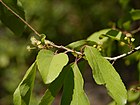Note: This is a project under development. The articles on this wiki are just being initiated and broadly incomplete. You can Help creating new pages.
Difference between revisions of "Flacourita indica"
| Line 1: | Line 1: | ||
[[File:Athrun (Marathi- अठरुन) (3260667132).jpg|thumb|right]] | [[File:Athrun (Marathi- अठरुन) (3260667132).jpg|thumb|right]] | ||
| + | '''Flacourita indica''' is a slow-growing, ornamental, spiny evergreen shrub or tree. It can reach a height of 10 metres, but is usually smaller. The tree is cultivated in some areas of the tropics, particularly in Asia, for its edible fruit. | ||
==Uses== | ==Uses== | ||
{{Uses|Fever}}, {{Uses|Diarrhoea}}, {{Uses|Inflammations}}, {{Uses|Asthma}}, {{Uses|Gynaecological complaints}}, {{Uses|Hydrocele}}, {{Uses|Pneumonia}}, {{Uses|Intestinal worms}}, {{Uses|Snake bites}}, {{Uses|Kidney complaints}}, {{Uses|Hoarseness}}.<ref name="Uses"/> | {{Uses|Fever}}, {{Uses|Diarrhoea}}, {{Uses|Inflammations}}, {{Uses|Asthma}}, {{Uses|Gynaecological complaints}}, {{Uses|Hydrocele}}, {{Uses|Pneumonia}}, {{Uses|Intestinal worms}}, {{Uses|Snake bites}}, {{Uses|Kidney complaints}}, {{Uses|Hoarseness}}.<ref name="Uses"/> | ||
Revision as of 10:25, 8 May 2020
Flacourita indica is a slow-growing, ornamental, spiny evergreen shrub or tree. It can reach a height of 10 metres, but is usually smaller. The tree is cultivated in some areas of the tropics, particularly in Asia, for its edible fruit.
Contents
- 1 Uses
- 2 Parts Used
- 3 Chemical Composition
- 4 Common names
- 5 Properties
- 6 Habit
- 7 Identification
- 8 List of Ayurvedic medicine in which the herb is used
- 9 Where to get the saplings
- 10 Mode of Propagation
- 11 How to plant/cultivate
- 12 Commonly seen growing in areas
- 13 Photo Gallery
- 14 References
- 15 External Links
Uses
Fever, Diarrhoea, Inflammations, Asthma, Gynaecological complaints, Hydrocele, Pneumonia, Intestinal worms, Snake bites, Kidney complaints, Hoarseness.[1]
Parts Used
Chemical Composition
Common names
| Language | Common name |
|---|---|
| Kannada | |
| Hindi | |
| Malayalam | |
| Tamil | |
| Telugu | |
| Marathi | |
| Gujarathi | |
| Punjabi | |
| Kashmiri | |
| Sanskrit | |
| English |
Properties
Reference: Dravya - Substance, Rasa - Taste, Guna - Qualities, Veerya - Potency, Vipaka - Post-digesion effect, Karma - Pharmacological activity, Prabhava - Therepeutics.
Dravya
Rasa
Guna
Veerya
Vipaka
Karma
Prabhava
Habit
Identification
Leaf
| Kind | Shape | Feature |
|---|---|---|
Flower
| Type | Size | Color and composition | Stamen | More information |
|---|---|---|---|---|
| {{{5}}} |
Fruit
| Type | Size | Mass | Appearance | Seeds | More information |
|---|---|---|---|---|---|
Other features
List of Ayurvedic medicine in which the herb is used
Where to get the saplings
Mode of Propagation
How to plant/cultivate
A very adaptable plant, it grows in the drier to moist tropics from sea level to an elevation of 2,400 metres.[4]
Commonly seen growing in areas
Dry deciduous, Thorn forests, Dry forest, Woodland, Bushland, Wooded grassland, Thickets.
Photo Gallery
References
- ↑ Indian Medicinal Plants by C.P.Khare
- ↑ [Chemistry]
- ↑ [Morphology]
- ↑ Cultivation
External Links
- Ayurvedic Herbs known to be helpful to treat Fever
- Ayurvedic Herbs known to be helpful to treat Diarrhoea
- Ayurvedic Herbs known to be helpful to treat Inflammations
- Ayurvedic Herbs known to be helpful to treat Asthma
- Ayurvedic Herbs known to be helpful to treat Gynaecological complaints
- Ayurvedic Herbs known to be helpful to treat Hydrocele
- Ayurvedic Herbs known to be helpful to treat Pneumonia
- Ayurvedic Herbs known to be helpful to treat Intestinal worms
- Ayurvedic Herbs known to be helpful to treat Snake bites
- Ayurvedic Herbs known to be helpful to treat Kidney complaints
- Ayurvedic Herbs known to be helpful to treat Hoarseness
- Herbs with Fruits used in medicine
- Habit - Deciduous tree
- Index of Plants which can be propagated by Seed
- Index of Plants which can be propagated by Layering
- Index of Plants which can be propagated by Grafting
- Herbs that are commonly seen in the region of Dry deciduous
- Herbs that are commonly seen in the region of Thorn forests
- Herbs that are commonly seen in the region of Dry forest
- Herbs that are commonly seen in the region of Woodland
- Herbs that are commonly seen in the region of Bushland
- Herbs that are commonly seen in the region of Wooded grassland
- Herbs that are commonly seen in the region of Thickets
- Herbs
- Pages without herbs images




